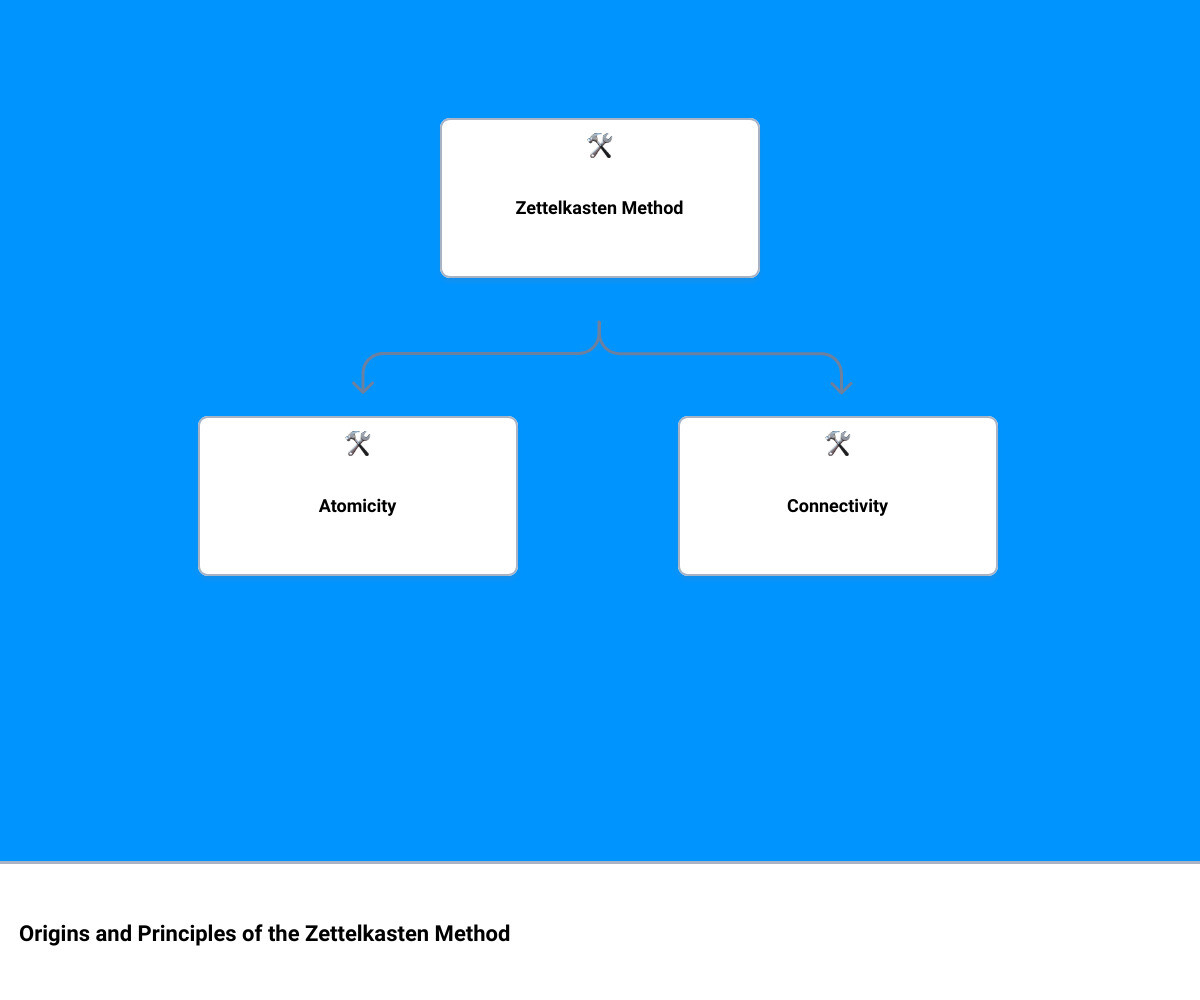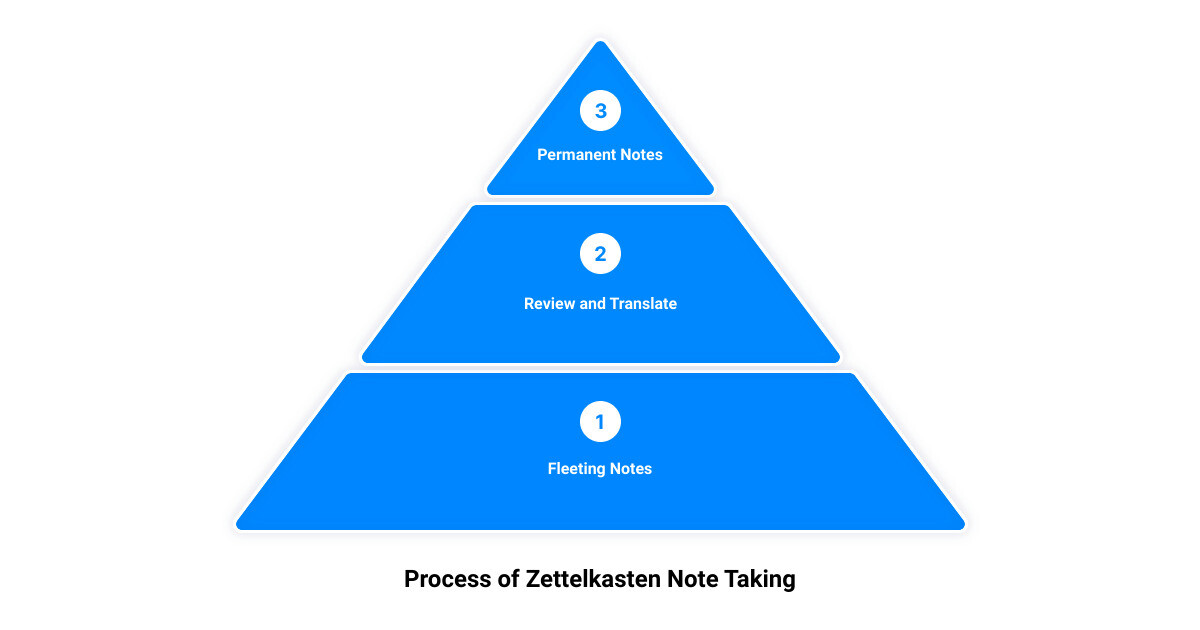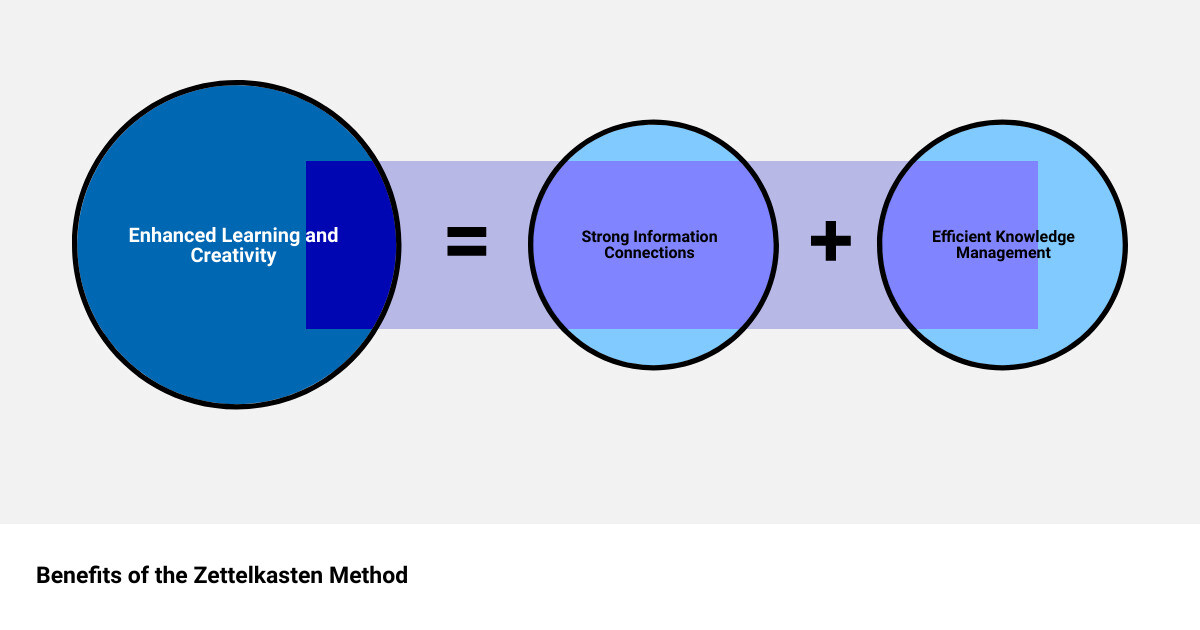Introduction to the Zettelkasten Note Taking Method
Let's face it: the modern world is a whirlwind of information. From online articles, podcasts, and webinars to academic lectures and books, we're constantly bombarded with new knowledge. As lifelong learners striving for efficiency in our learning journey, we often struggle with organizing this information, creating meaningful connections between different pieces, and retaining what we've learned. Enter the Zettelkasten method, a revolutionary note-taking strategy that offers a solution to these challenges.
The Zettelkasten method, a system born out of the ingenious mind of German sociologist Niklas Luhmann, has the ability to transform the way we engage with information. It's much more than a mere note-taking technique; it's a strategic process for knowledge management and idea generation.
By leveraging the principles of atomicity and connectivity, the Zettelkasten method allows us to break down complex ideas into understandable pieces, and then connect these pieces to form a network of knowledge. This isn't just about storing information for future reference; it's about sparking new insights and understanding through the interplay of ideas.
Whether you're diving into the intricacies of Mandarin and Chinese characters or exploring the depths of cognitive science, the Zettelkasten method can be your reliable guide. It helps you systematically organize important information, find it again even years later, and develop your own ideas. Ready to unlock higher levels of creativity and productivity in your learning journey? Let's delve deeper into the principles and practices of the Zettelkasten method.

The Origins and Principles of the Zettelkasten Method
Like an archaeologist dusting off an ancient artifact, let's unearth the roots of the Zettelkasten method and reveal the principles that make it a game-changing tool for learners and creatives alike.
The Invention of the Zettelkasten Method by Niklas Luhmann
The Zettelkasten method was not born in a Silicon Valley brainstorming session, but in the hands of German sociologist Niklas Luhmann in the mid-20th century. Luhmann was not only an acclaimed sociologist but a prolific writer, credited with over 50 books and hundreds of academic articles. The secret sauce behind his staggering productivity? You guessed it - the Zettelkasten method.
Despite its seemingly humble beginnings, this method is anything but ordinary. Luhmann used a simple box to store his ever-growing collection of index cards, each containing a single idea or piece of information. This system of capturing and categorizing thoughts on discrete cards laid the foundation of the Zettelkasten method and its remarkable ability to transform information into knowledge.
The Principle of Atomicity in the Zettelkasten Method
The Zettelkasten method is not just a way of taking notes; it's a philosophy of knowledge management. At its core is the principle of atomicity, which advocates for breaking down information into its smallest possible components. Each note, or Zettel, captures a single idea or piece of information, making it easier to interlink individual thoughts and build a more comprehensive understanding of a topic.
The principle of atomicity ensures each note stands on its own, independent yet interconnected. This approach to note-taking is akin to breaking down a complex problem into manageable chunks, making it easier to comprehend and solve. The Zettelkasten method empowers you to distill information into its essence, enhancing your comprehension and retention of knowledge.
The Principle of Connectivity in the Zettelkasten Method
The magic of the Zettelkasten method is not just in the creation of individual notes, but in the connections between them. The principle of connectivity underpins the Zettelkasten method, encouraging you to create links between related notes. This forms a web of interconnected ideas, enabling a more complete understanding of a particular topic.
These connections are not just static links but dynamic pathways that guide you through your own unique network of knowledge. They act as bridges between ideas, enabling you to navigate your thought landscape with ease. This approach fosters creativity, as it encourages the cross-pollination of ideas and sparks new insights.
In essence, the Zettelkasten method is more than a note-taking technique; it's a powerful strategy for learning and knowledge management. Through the principles of atomicity and connectivity, it transforms the way you capture, process, and connect information, paving the way for deeper understanding and creative breakthroughs.

The Zettelkasten Method in Practice: From Fleeting Notes to Permanent Knowledge
Unlocking new levels of understanding and creativity is a journey, and like any journey, it begins with a single step. In the case of the Zettelkasten method, the first step is gathering your thoughts and information through two types of notes: fleeting notes and literature notes.
The Role of Fleeting Notes and Literature Notes
Fleeting notes are the initial raw observations or ideas you jot down when a spark of insight strikes or when you stumble upon an interesting piece of information. These notes, as the name suggests, are fleeting and ephemeral. They capture the essence of the moment without any commitment to permanence.
In contrast, literature notes are more deliberate and methodical. Created when you dive deep into a resource such as a book or an article, literature notes summarize and comment on the content. They are more detailed and articulate, written in your own words to ensure a better understanding of the concept. These notes form the basis for your knowledge repository and play a vital role in your referencing system.
The Process of Reviewing and Translating Notes into Permanent Ones
After you've collected your fleeting and literature notes, the next step in the Zettelkasten method is to review them. This isn't a mere act of reading through; it's about deciding which tidbits are worth keeping and translating them into permanent notes.
The permanent notes are the jewels in your Zettelkasten crown. They are the refined, distilled ideas that have passed the test of your scrutiny and that you wish to explore further. The act of creating permanent notes is a thoughtful process where you evaluate how a piece of information adds to, supports, or contradicts your existing knowledge. This process encourages the development of new insights and deepens your understanding of the topic.
The Use of a Numbering System to Link Thoughts and Form Connections
The secret sauce of the Zettelkasten method lies in its ability to form connections between different pieces of information. And the tool for creating these connections is a unique numbering system. Instead of categorizing and filing notes based on topics, which can limit understanding to a particular discipline, the Zettelkasten method assigns each card a fixed number.
As you add more notes, you can "link" thoughts together by expanding on the numbering system. For example, card 1/1 contains the original idea, card 1/1a builds on it, and card 1/1b1 refers to an idea from card 1/1b. This numbering system acts as a series of breadcrumbs, guiding you through your knowledge labyrinth and allowing you to see the intricate network of interconnected thoughts.
In essence, the Zettelkasten method transforms note-taking from a static process of data collection into a dynamic process of knowledge creation. By capturing fleeting thoughts, diving deep into literature notes, and forging connections through permanent notes, you develop a rich, interconnected web of knowledge that fuels creativity and boosts productivity.
Implementing the Zettelkasten Method in the Digital Age
In the digital age, the Zettelkasten method has taken on a new level of potential. With the rise of technology, you can now create, manage, and link your notes with unprecedented ease and efficiency. Let's delve into how you can leverage digital tools to implement this revolutionary note-taking technique.
Using Digital Tools for the Zettelkasten Method: Spreadsheets, Trello Boards, and Confluence Documents
While you can certainly use physical note cards like Niklas Luhmann did, digital tools offer a level of flexibility and accessibility that is hard to match. Spreadsheets can be used for creating an overview of your notes, while Trello boards and Confluence documents can provide a visual representation of the connections between your thoughts. These tools allow for easy editing, searching, and linking, making your note-taking process more efficient.
The Best Note Apps for Zettelkasten: Amplenote, Obsidian, Notion, RemNote
When it comes to digital note-taking, several apps stand out for their Zettelkasten-friendly features. Amplenote, Obsidian, Notion, and RemNote are some of the leading apps that can help you implement the Zettelkasten method. These apps offer easy note creation, robust linking features, and intuitive organization systems, making them ideal for Zettelkasten note-taking. But remember, the software you choose should align with your individual learning style and workflow.
How Traverse App Incorporates the Zettelkasten Method for Effective Learning
For our lifelong learners, such as those trying to learn Mandarin, Traverse is a standout choice. Traverse is designed to incorporate the Zettelkasten Method into its core functionality, making it an excellent tool for effective learning.
Traverse offers features that make it easy to create atomic notes, or individual pieces of information, and connect them together. This connection of ideas, central to the Zettelkasten Method, aids in forming a comprehensive understanding of complex topics, like Mandarin.
Beyond just note-taking, Traverse also employs spaced repetition, a scientifically proven technique for improving memory recall. Regular review and connection of notes become a seamless part of your learning journey, helping you absorb and retain information more effectively.
In conclusion, while the Zettelkasten Method may have its roots in traditional note cards, it has found a powerful ally in the digital tools of today. With the right app, you can unlock the full potential of this method, enhancing your learning and productivity in the process.

The Benefits of the Zettelkasten Method for Learning and Creativity
Are you tired of forgetting important information or struggling to connect the dots between different pieces of knowledge? The Zettelkasten note-taking method offers a revolutionary approach to learning and creativity that can supercharge your cognitive abilities. Let's dive into the benefits of this unique system.
Forming Strong Connections Between Different Pieces of Information
The Zettelkasten method is not your typical linear note-taking system. It's a dynamic, interdisciplinary approach that encourages the formation of robust connections between different pieces of information. For instance, while learning Mandarin, you might come across a nugget of knowledge about a specific Chinese character. A lightbulb moment might connect this newfound understanding to a previously learned concept in Chinese grammar. These are connections that a rigid, hierarchical note-taking system might not facilitate. The Zettelkasten method empowers you to build a rich, interconnected web of knowledge, enhancing the depth of your understanding.
Improving Retention and Recall of Information
One of the key principles of the Zettelkasten method is writing notes in your own words. This might seem like extra work, but it has a solid cognitive basis. Research indicates that the process of rephrasing and writing down information helps to cement it in our memory, improving our ability to retain and recall it. Also, the unique numbering system of the Zettelkasten method supports quick retrieval of information. So, the next time you need to recall that complex Chinese character, the Zettelkasten method has your back.
Boosting Efficiency in Learning and Knowledge Management
The Zettelkasten method is like having a personalized database of knowledge at your fingertips. It saves you from the time-consuming hassle of rummaging through random documents, email threads, or sticky notes. Instead of managing information, you can focus on absorbing and applying it. A study by the University of California revealed that using a digital note-taking system like the Zettelkasten can lead to a 30% increase in productivity and time savings. So, whether you're studying Mandarin or exploring cognitive science, Zettelkasten can supercharge your learning journey.
Combating Information Overload and Supporting Knowledge Sharing
In the age of information overload, the Zettelkasten method provides a lifeline. It mimics the way our brains work, functioning as a constantly running, interconnected log of information, rather than a rigid filing system. This can help you manage and make sense of the avalanche of information you encounter daily. The beauty of Zettelkasten is that it's not just personal. You can use it with your team, getting crucial information out of individual brains (or inboxes) and into a centralized and systemized database. This fosters a culture of knowledge sharing and collective learning.
In summary, the Zettelkasten method is more than a note-taking system. It's a powerful tool for improving information retention, enhancing knowledge management, and fostering creativity. Whether you're learning a new language or tackling a complex project, the Zettelkasten method can help unlock your full potential.
Tips and Strategies for Maximizing the Zettelkasten Method
Successful application of the Zettelkasten method involves more than just understanding its principles and steps. It requires adopting certain practices and strategies that enhance its effectiveness. In this section, we'll explore some of these strategies, including creating a daily writing practice, using outlines for better organization, and creating a bibliography and using the Barbell method of reading.
Creating a Daily Writing Practice
One of the most effective strategies for maximizing the Zettelkasten method is to develop a daily writing practice. Remember, the Zettelkasten method is not just about collecting information, but also about processing and connecting it. This is where daily writing comes in.
By writing daily, you're constantly engaging with the information you've gathered, translating it into your own words, and making connections between different pieces of information. This consistent engagement with your notes encourages the development of your thoughts and helps you create an interconnected web of ideas.
Using Outlines for Better Organization
Another helpful strategy is the use of outlines. Outlines can serve as "Hub notes" in your Zettelkasten, acting as an index or table of contents for your notes. They provide a high-level structure to your notes, enabling you to see the bigger picture and make connections between different topics.
When starting a new writing project, you can use outlines to kickstart the first draft of your work. Simply add Zettel notes to the outline, pasting their contents in, and voila – you have a structured draft ready for refinement.
Creating a Bibliography and Using the Barbell Method of Reading
Lastly, consider creating a bibliography and using the Barbell method of reading. A bibliography helps you keep track of the sources of your notes, which is crucial for academic integrity and for revisiting sources for deeper understanding or clarification.
The Barbell method of reading, on the other hand, involves reading a mix of both easy, enjoyable books and challenging, rigorous texts. This method ensures that you're constantly being exposed to new ideas, while also taking the time to delve deep into complex subjects.
In the context of Zettelkasten, this could mean making a conscious effort to include a variety of sources in your note-taking, from simple summaries to deep-dive academic papers. This diversity of sources will enrich your Zettelkasten and broaden your understanding of the topics you're studying.
In conclusion, the Zettelkasten method is a powerful tool for learning and productivity, but to truly unlock its potential, you need to integrate it into your daily habits and practices. By adopting strategies like daily writing, using outlines, and diversifying your sources, you can make the most of this revolutionary approach to note-taking.
Conclusion: The Zettelkasten Method as a Revolutionary Approach to Note Taking
As we have seen, note-taking doesn't have to be a tedious, mind-numbing activity that leaves you with a jumbled mess of information. The Zettelkasten method transforms note-taking into a dynamic and engaging process that enhances your learning and boosts your creativity. It’s not just about storing data — it’s about creating a network of interconnected thoughts, sparking new ideas, and making knowledge truly your own.
The method stands as a revolutionary approach in the world of note-taking and knowledge management. By embracing atomicity and connectivity, it breaks down complex ideas into manageable pieces and forms strong links between different pieces of information. It provides a framework for turning fleeting notes into permanent knowledge, and it's adaptable to both the analog and digital world with a variety of tools and apps available.
For the lifelong learner, the benefits are clear: improved retention and recall of information, increased efficiency in learning, and a powerful weapon against information overload. It's no wonder that many have found the Zettelkasten method to be a game-changer in their learning journey, whether it's mastering Mandarin, understanding the intricacies of machine learning, or diving into any other field of study.
However, like any robust system, the Zettelkasten method is not a quick fix. It requires commitment, consistency, and a willingness to rethink traditional approaches to note-taking and learning. But for those who are willing to take the leap, the rewards can be immense.
As a final note, remember that the Zettelkasten method is not a rigid set of rules, but a flexible system that can be adapted to fit your unique learning style and needs. It serves as a guide, not a commandment. Don't be afraid to experiment, adjust, and find the approach that works best for you.
In conclusion, the Zettelkasten method is more than a note-taking system - it’s a way of thinking, a way of learning, and a way of sparking creativity. It’s a strategy for lifelong learning and knowledge management that is as effective as it is revolutionary. Give it a try, and unlock your potential for learning and productivity like never before.

